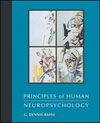G. Dennis Rains,
Kutztown University of Pennsylvania
| alternative strategies | Rehabilitation interventions that attempt to utilize the ways of processing that remain within the person's cognitive repertory after a cerebral lesion, but that are distinct from the way in which the individual performed the task before the lesion.
|
 |
 |
 |
| anterograde (Wallerian) degeneration | Degeneration of the length of an axon distal to the point of damage. Also called Wallerian degeneration.
|
 |
 |
 |
| autoneurotoxicity | Neuronal responses to insult that further damage neuronal tissue. An example is the excessive release of glutamate by cells in the hippocampus in response to oxygen deprivation. This overexcites hippocampal neurons, causing their death.
|
 |
 |
 |
| crowding | The idea that the reorganization of right-hemisphere function after an early left-hemisphere lesion, and the resulting takeover of language by the right hemisphere, is achieved at the cost of impairment in general intellectual functioning.
|
 |
 |
 |
| denervated (collateral) sprouting | The processes in which neurons with connections to areas neighboring a denervated area sprout additional terminals that form connections with the denervated area.
|
 |
 |
 |
| denervation supersensitivity | The phenomenon following partial denervation of a structure (neural or muscular) in which the structure becomes hypersensitive to the application of its neurotransmitter.
|
 |
 |
 |
| diaschisis | The temporary disruptive effect that a cerebral lesion may exert on neighboring or even distant neural tissue. This may take the form of swelling, bleeding, or other short-term pathological processes.
|
 |
 |
 |
| edema | Swelling; the presence of abnormally large amounts of fluid in the intercellular spaces of the body.
|
 |
 |
 |
| externally focused interventions | Rehabilitation interventions that address the problems that fol-low a brain lesion by modifying the individual's environment.
|
 |
 |
 |
| gliosis | The reactive proliferation of glial cells in response to the removal of dead neurons by phagocytes. This forms a scar in the area, which may interfere with the functioning of any surviving neurons.
|
 |
 |
 |
| Kennard principle | The principle that the earlier in life a lesion is sustained, the better the recovery.
|
 |
 |
 |
| lesion momentum | The rate of development of a progressive lesion (e.g., a tumor).
|
 |
 |
 |
| necrosis | Tissue (cell) death.
|
 |
 |
 |
| nerve growth factor (NGF) | A molecule that is important for aspects of central nervous system development and that also plays a role in the development of new connections after brain lesions.
|
 |
 |
 |
| process-specific approach | A restorative intervention approach to rehabilitation that attempts to identify the specific cognitive processes that are impaired in an individual and then designs exercises that serve as vehicles for practicing those processes.
|
 |
 |
 |
| rerouting | The process in which a neuron whose target has been lost (due to a lesion) grows to and connects with a new target.
|
 |
 |
 |
| restorative interventions | Rehabilitation interventions that attempt to change an individual's cognitive capabilities after a brain lesion.
|
 |
 |
 |
| retrograde degeneration | Degeneration spreading from the point of transection of an axon back to the cell body (as opposed to anterograde or Wallerian degeneration).
|
 |
 |
 |
| spinal shock | Temporary loss of spinal reflexes after spinal transection.
|
 |
 |
 |
| staged-lesion effect | The finding that the effect of a staged lesion on function is much less than the effect of a single lesion of the same size and in the same location.
|
 |
 |
 |
| transneuronal degeneration | Degeneration extending to neurons that have synaptic connections with a damaged neuron.
|



 2002 McGraw-Hill Higher Education
2002 McGraw-Hill Higher Education

 2002 McGraw-Hill Higher Education
2002 McGraw-Hill Higher Education